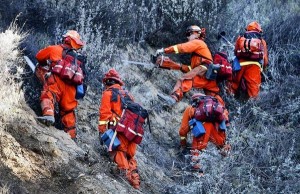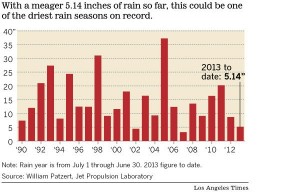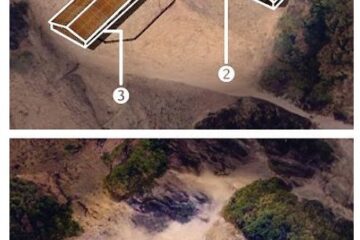Dry weather has firefighters ready for battle
In L.A. County, tests show brush is drying out fast this year because of lack of rain. In Ventura County, firefighters say the parched conditions are more typical of June or July.
Source of this article: The Los Angeles Times, April 20, 2013
Southern California is marching toward its fourth-driest year since 1877, and that has firefighters increasingly girded for battle.
 In the hills of Los Angeles County, tests show the brush is drying out at a significantly quicker rate this year because of the lack of rain. In Ventura County, firefighters say the parched conditions feel like what they typically see in June or July. The California Department of Forestry and Fire Protection, which handles fire protection for about a third of the state, said it has dealt with 150 more blazes so far this year compared with 2012.
In the hills of Los Angeles County, tests show the brush is drying out at a significantly quicker rate this year because of the lack of rain. In Ventura County, firefighters say the parched conditions feel like what they typically see in June or July. The California Department of Forestry and Fire Protection, which handles fire protection for about a third of the state, said it has dealt with 150 more blazes so far this year compared with 2012.
“We’ve had some large fires in Inyo County, which typically doesn’t have fires in the winter,” said spokesman Daniel Berlant. “Many areas of California are seeing larger fires much earlier in the year, and it relates to the fact that January, February and March have been really dry throughout California.”
Cal Fire announced it was deploying fire crews early this year in some areas, including the Inland Empire, because of what it described as “extreme” dry conditions.
Other departments said they are on high alert, especially with forecasts that call for two weeks of warming temperatures and gusty offshore winds. The National Weather Service warned of dry, gusty winds in some areas through at least Saturday and issued a red-flag fire warning for much of San Diego County.
Los Angeles has seen only 5.14 inches of rain this year; normal would be 14 inches. Forecasters are increasingly skeptical of any significant storms on the way before summer.
 “We’re so close to the end of the rainy season and we really rarely get that much rain beyond this point,” said David Sweet, a meteorologist for the National Weather Service in Oxnard.
“We’re so close to the end of the rainy season and we really rarely get that much rain beyond this point,” said David Sweet, a meteorologist for the National Weather Service in Oxnard.
William Patzert, the climatologist for the Jet Propulsion Laboratory in La Cañada-Flintridge, said that if the trend continues, it would mean three of L.A.’s four driest years in the last 135 years occurred in the last decade alone.
“We had a pretty good start to the rainy season in the fall, but when the new year showed up, the spigot just shut off,” he said, adding jokingly: “It’s so dry in Los Angeles that crooks are siphoning off radiators instead of gas tanks.”
Swaths of California recorded the smallest rainfall total in history for January, February and March — normally the wettest months. This has left the snowpack in the Sierra Nevada, an important part of the state’s water supply, far lower than usual. The dry conditions are also making it difficult for officials to replant forest areas because there’s not enough moisture.
Rain or water years are measured from July 1 of one year to June 30 of the next. The driest year in L.A.’s recorded history was 2006-07, when a meager 3.21 inches of rain fell. That broke the record set in 2002-03, when 4.42 inches fell. The third-driest year was 1961, when just under 5 inches fell.
The current fourth-driest year saw 5.58 inches in 1959, and weather experts said this year will almost certainly beat that record.
“Don’t let some of the green out there fool you,” said Los Angeles Fire Department Capt. Tony Valdez, who is in charge of brush clearance for the city. “We get the occasional rains that spur growth, but underneath the conditions aren’t good.”
L.A. fire Capt. Jamie Moore said flying over the city last week provided a sobering picture of just how dry the landscape has become.
“It is alarming how much the brush has grown since last season,” he said. “We have a lot of dry underbrush. We have 20- or 30-foot-tall trees with brush and undergrowth.”
Last week, a wind-driven brush fire broke out near Fillmore and quickly devoured 150 acres of dry hillside, forcing evacuations and threatening homes.
Ventura County Fire Capt. Scott Quirarte said it was the kind of blaze they normally see in the summer or fall. But the conditions this year were different. It rained just enough in the fall to grow grasses, but it has become so dry that the net result could be more fuel for future fires.
With the rainy season close to over, firefighters and weather experts are counting on the cloudy “May gray” and “June gloom” weather conditions to provide a measure of moisture and relief.
“If the marine layer is depressed and we have a pretty warm spring and early summer, then we’re going to be seeing a lot more fire activity earlier this season, and the fires will be bigger than they normally are,” said Tom Rolinski, a meteorologist with the U.S. Forest Service’s Predictive Services Program.
The lack of rain can be seen across the landscape.
In the Antelope Valley California Poppy Reserve, fields of orange poppies have been replaced with a brown shag rug, with no pretty flowers blooming this year. That has sent the number of visitors plummeting.
And in places like Central California, farmers are already thinking about how to manage resources and crop yields into the next year as they prepare for a shrinking allotment of purchased water from the state and federal governments.
“People are going crazy now,” said Steve Patricio, a cantaloupe and melon farmer. “When you’re a farmer in Central California, you absolutely watch the water as much as you watch your kids.”
So far, officials say they don’t see problems with the water supply. Jeff Kightlinger, general manager for the Metropolitan Water District of Southern California, said the agency is in good shape because it has stored water from stronger rain years.
Most of Southern California’s water is imported, and most of the places that supply the region have seen very little rain, including the Owens Valley, the Colorado River and the Sierra.
“We don’t intend to call for any rationing this year,” Kightlinger said. “But we’re keeping a close eye on this if this becomes a two- or three-year trend.”
For now, forecasters are looking nervously at the forecast for the next two weeks.
Rolinski, of the U.S. Forest Service, said live fuel moisture levels in Southern California are lower than they should be and that there’s already concern about possible Santa Ana winds in the region early next week.
“Over the next couple of weeks, there’s some offshore wind events we’re concerned about because it’s basically going to be on the warm side,” Rolinski said.
That’s fire weather.



0 Comments